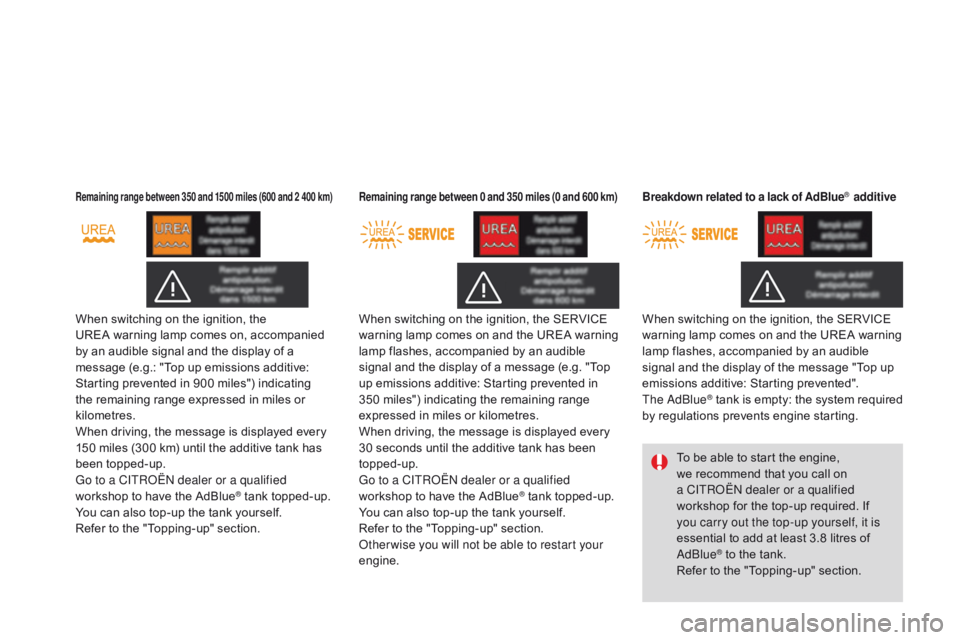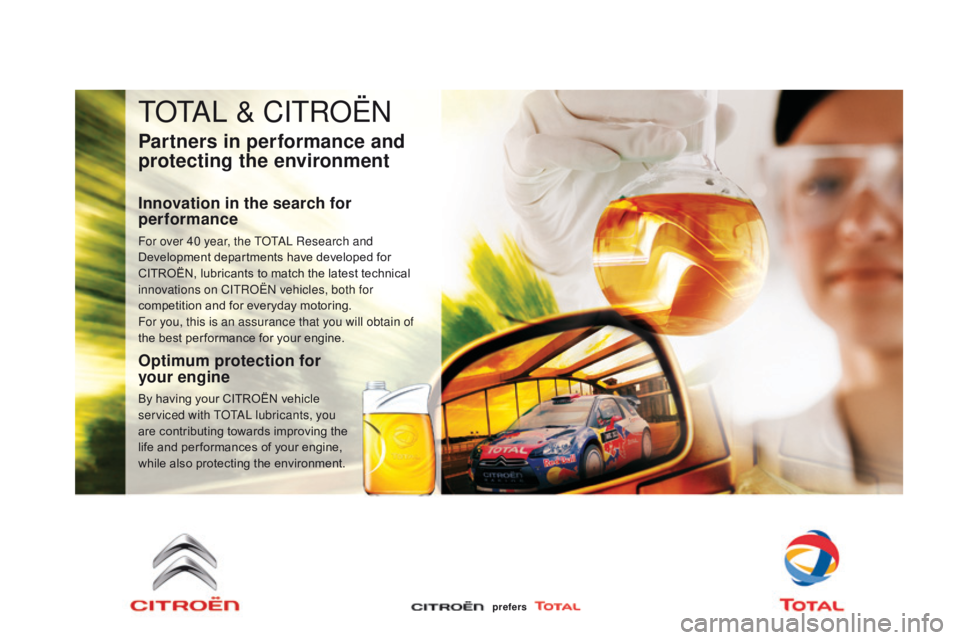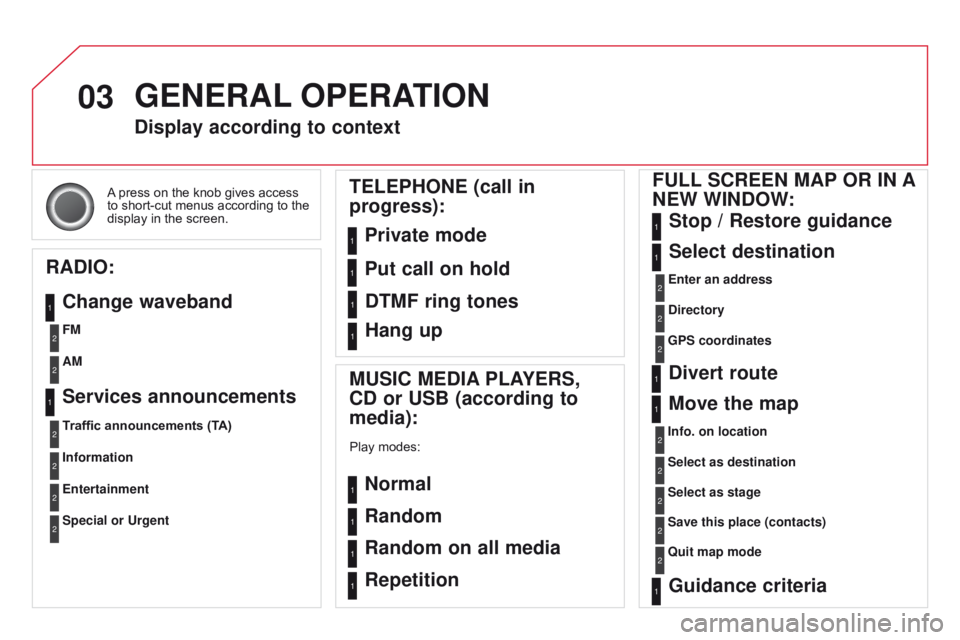service CITROEN DS3 CABRIO DAG 2015 Handbook (in English)
[x] Cancel search | Manufacturer: CITROEN, Model Year: 2015, Model line: DS3 CABRIO DAG, Model: CITROEN DS3 CABRIO DAG 2015Pages: 404, PDF Size: 13.93 MB
Page 198 of 404

DS3_en_Chap10_info-pratiques_ed01-2014
Remaining range between 350 and 1500 miles (600 and 2 400 km)
When switching on the ignition, the UREA warning lamp comes on, accompanied
b
y an audible signal and the display of a
m
essage (e.g.: "Top up emissions additive:
S
tarting prevented in 900 miles") indicating
t
he remaining range expressed in miles or
k
ilometres.
When
driving, the message is displayed every
1
50 miles (300 km) until the additive tank has
be
en
t
opped-up.
Go to a CITR
oË
N dealer or a qualified
workshop
to have the AdBlue
® tank topped-up.
Y
ou
can
also
top-up
the
tank
yourself.
Refer
to
the
"Topping-up"
section. When
switching on the ignition, the SERVICE
w
arning lamp comes on and the UREA warning
l
amp flashes, accompanied by an audible
s
ignal and the display of a message (e.g. "Top
u
p emissions additive: Starting prevented in
3
50 miles") indicating the remaining range
e
xpressed in miles or kilometres.
When driving, the message is displayed every
3
0 seconds until the additive tank has been
t
opped-up.
Go to a CITR
oË
N dealer or a qualified
workshop to have the AdBlue® tank topped-up.
Y
ou
can
also
top-up
the
tank
yourself.
Refer
to
the
"Topping-up"
section.
ot
her wise you will not be able to restart your
engine.
Remaining range between 0 and 350 miles (0 and 600 km)
When switching on the ignition, the SERVICE w arning lamp comes on and the UREA warning
l
amp flashes, accompanied by an audible
s
ignal and the display of the message "Top up
e
missions additive: Starting prevented".
The
a d
blu
e
® tank is empty: t he s ystem r equired b
y
regulations prevents engine starting.
Breakdown related to a lack of AdBlue® additive
To be able to start the engine, w
e recommend that you call on
a C
ITR
oË
N dealer or a qualified
workshop
for the top-up required. If
y
ou carry out the top-up yourself, it is
essential
to add at least 3.8 litres of
a
d
blu
e
® to the tank.
R
efer
to
the "Topping-up" section.
Page 200 of 404

DS3_en_Chap10_info-pratiques_ed01-2014
Freezing of the AdBlue®
additive
The adblue® additive freezes at
temperatures below around -11°C.
The
SCR
system includes a heater for
t
he
a
d
blu
e
® tank.
I
n
exceptional circumstances (vehicle
k
ept
for
a
long period at temperatures
t
hat
are
constantly below -15°C), an
e
missions
control system fault alert
m
ay
be
related to freezing of the
a
d
blu
e
® in your vehicle.
P
ark
your vehicle in a warmer area for
a
few
hours until the additive becomes
li
quid
a
gain.
The
emissions alert does not go off
i
mmediately, it will occur after several
m
ile
of
running.
You
have
exceeded
the
authorised
d
riving
limit:
the
starting
prevention
s
ystem
inhibits
engine
starting.
Every time the ignition is switched on, the SERVICE a nd engine diagnostic warning lamps come on and t
he UREA warning lamp flashes, accompanied by
a
n audible signal and the display of the message
"
Emissions fault: Starting prevented".
Starting prevented
To
be able to start the engine, you must call on
a
CITROËN dealer or a qualified workshop.
Page 201 of 404

199
DS3_en_Chap10_info-pratiques_ed01-2014
keep a dblu e® out of the reach of
children,
in
its
original bottle.
Never transfer
a d
blu
e
® to another
container:
it
would
loose its purity. Never
dilute the additive with water.
Never pour the additive into the Diesel
fuel tank.
Never top-up from an AdBlue®
dispenser
reserved
for
heavy
goods
v
ehicles.
Filling
the
AdBlue
® tank is an operation i
ncluded in every routine service on your
vehicle by a CITR
oË
N dealer or a qualified
workshop.
Nevertheless,
given the capacity of the tank,
i
t
may
be
necessary to top-up the additive
b
etween
services,
more particularly if an alert
(
warning
lamps
and a message) signals the
r
equirement.
You
can
got
to
a
CITROËN dealer or a qualified
w
orkshop.
If
you
envisage
topping-up yourself, please
r
ead
the
following
warnings carefully.
Topping-up the AdBlue® additive
Precautions in use
Use only adblu e® additive that meets the I
SO 22241
standard.
The
supply
in
a
non-drip bottle simplifies
t
oping-up.
You
can obtain 1.89 litre (half a US
g
allon)
bottles
from a CITROËN dealer or a
q
ualified
w
orkshop.
The
a
dblu
e® additive is an urea-based
solution.
This liquid is non-flammable,
c
olourless
and odourless (kept in a cool area).
In
the
event
of contact with the skin, wash
t
he
affected
area with soap and water. In the
e
vent
of
contact with the eyes, wash (irrigate)
t
he
eyes
with large amounts of water or with
a
n
eye
wash
solution for at least 15 minutes.
I
f
a
burning
sensation or irritation persists, get
m
edical
attention.
If
swallowed, immediately wash out the mouth
w
ith
clean
water and then drink plenty of water.
In
certain
conditions (high ambient
t
emperature,
for example), the risk of release
o
f
ammonia
cannot be excluded: do not inhale
t
he
product.
Ammonia vapour has en irritant
e
ffect
on
mucous membranes (eyes, nose and
t
hroat).
Practical information
Page 238 of 404

DS3_en_Chap10_info-pratiques_ed01-2014
Towing the vehicleProcedure for having your vehicle towed or for towing another vehicle using a removable towing eye.
T he towing eye is installed in the boot under
t
he floor.
To
gain access to it:
F
o
pen the boot,
F
r
aise the floor,
F
r
emove the polystyrene storage box,
F
r
emove the towing eye from the holder.
Access to the tools General recommendations
Observe the legislation in force in your country.
E nsure that the weight of the towing vehicle is higher than that of the towed vehicle.
The
driver must remain at the wheel of the towed vehicle and must have a valid driving licence.
When
towing a vehicle with all four wheels on the ground, always use an approved towing
a
rm; rope and straps are prohibited.
The
towing vehicle must move off gently.
When
towing a vehicle with the engine off, there is no longer any power assistance for
b
raking or steering.
In
the following cases, you must always call on a professional recovery service:
-
v
ehicle broken down on a motor way or fast road,
-
f
our-wheel drive vehicle,
-
w
hen it is not possible to put the gearbox into neutral, unlock the steering, or release
t
he parking brake,
-
t
owing with only two wheels on the ground,
-
w
here there is no approved towing arm available...
Page 248 of 404

DS3_en_Chap11_verifications_ed01-2014
ToTaL & CITRoËN
Partners in performance and
protecting the environment
Innovation in the search for
performance
For over 40 year, the ToTaL R esearch and
Development departments have developed for
C
ITROËN, lubricants to match the latest technical
i
nnovations on CITR
oË
N vehicles, both for
competition
and for everyday motoring.
For you, this is an assurance that you will obtain of
the
best per formance for your engine.
Optimum protection for
your engine
By having your CITROËN vehicle serviced with ToTaL l ubricants, you
are
contributing towards improving the
l
ife and per formances of your engine,
w
hile also protecting the environment.
prefers
Page 253 of 404

251
DS3_en_Chap11_verifications_ed01-2014
Checking levels
Check all of these levels regularly, in line with the maintenance and warranty guide. Top them up if necessary, unless other wise indicated.
I f a level drops significantly, have the corresponding system checked by a CITROËN dealer or a qualified workshop.
Engine oil level
It is normal to top up the oil level between two services (or oil changes). CITROËN
r
ecommends that you check the level, and top
u
p if necessary, every 3 000 miles (5 000 kms).
The
check is carried out either when
t
he ignition is switched on using the
o
il level indicator in the instrument
p
anel for vehicles with an electric oil
level gauge, or using the dipstick.
To ensure that the reading is correct,
y
our vehicle must be parked on a level
s
ur face with the engine having been off
f
or more than 30 minutes.
Take care when working under the
b
onnet, as certain areas of the engine
m
ay be extremely hot (risk of burns)
a
nd the cooling fan could start at any
t
ime (even with the ignition off).
checking using the dipstick
A = MA X
B = MIN If you find that the level is above the A
mark or
belo
w the B mark, do not star t the engine
.
-
I
f the level is above the MAX
mark (risk
o
f damage to the engine), contact a
C
ITROËN dealer or a qualified workshop.
-
I
f the level is below the MIN
mark, you
m
ust top up the engine oil.
Refer
to
the
"Petrol engine" or "Diesel engine"
s
ection
for
the location of the dipstick in the
e
ngine
compartment of your vehicle.
F
T
ake
the
dipstick by its coloured grip and
r
emove
it completely.
F
W
ipe
the
end of the dipstick using a clean
n
on-fluffy cloth.
F
R
efit
the
dipstick and push fully down, then
p
ull
it
out again to make the visual check:
t
he
correct level is between the marks A
and B .
Oil grade
Before topping-up the oil or changing the oil, c
heck that the oil is the correct grade for your
e
ngine and conforms to the manufacturer's
r
ecommendations.
checks
Page 258 of 404

DS3_en_Chap11_verifications_ed01-2014
Manual gearbox
Automatic gearboxBrake pads
Brake wear depends on the style o
f driving, particularly in the case o
f vehicles used in town, over short
distances.
It may be necessary to have
t
he condition of the brakes checked,
e
ven between vehicle services.
The
gearbox
does
not
require
any
m
aintenance
(no
oil
change).
Refer
to
the
maintenance
and
w
arranty
guide
for
the
checking
i
nterval
for
this
component.
Only
use products recommended by
C
ITR
oË
N or products of equivalent
quality
an
d
sp
ecification.
In
order to optimise the operation of
u
nits as important as those in the
b
raking system, CITROËN selects and
o
ffers very specific products.
The
gearbox
does
not
require
any
m
aintenance
(no
oil
change).
Refer
to
the
maintenance
and
w
arranty
guide
for
details
of
the
level
c
hecking
interval
for
this
component.
Electronic gearbox
The gearbox does not require any m aintenance (no oil change).
Refer
to the maintenance and
w
arranty guide for details of the
c
hecking interval for this component. For
information on checking brake
d
isc wear, contact a CITR
oË
N dealer
or
a qualified workshop.
Brake disc wearParking brake
If excessive travel or a loss of e
ffectiveness of this system is
n
oticed, the parking brake must be
c
hecked, even between two services.
Unless
there
is
a
leak
in
the
circuit,
a
drop
in
t
he
brake
fluid
level
indicates
that
the
brake
p
ads
are
worn. Checking
this system must be done by a
C
ITROËN dealer or a qualified workshop.
After
washing
the
vehicle,
dampness,
o
r
in
wintry
conditions,
ice
can
form
o
n
the
brake
discs
and
pads:
braking
e
fficiency
may
be
reduced.
Make
light
b
rake
applications
to
dry
and
defrost
t
he
brakes.
Page 282 of 404

DS3_en_Chap13a_bTa_ed01-2014
EMERGENcY OR ASSIST AN c E c ALL
cITROËN Localised Emergency call
In an emergency, press this button for more than 2
seconds. Flashing of the green LED and a voice
message
confirm that the call has been made to the
C
ITR o ËN Localised Emergency Call centre*.
Pressing
this
button again immediately cancels the call.
The
green LED
goes
off.
Pressing
this
button (at any time) for more than 8 seconds cancels the call.
cITROËN Localised Assistance call
When the ignition is switched on, the green LED comes on for 3 seconds
indicating
that the system is operating
correctly
.
If
the orange LED flashes: there is a
system
fault.
If
the orange LED is on continuously: the
backup
battery must be replaced.
In either case, contact a CITR
o ËN
dealer.
Pressing
this
button
again
immediately cancels the request.
The
cancellation
is
confirmed
by
a voice message.
Press
this
button for more than 2 seconds to request
assistance
if
the
vehicle breaks down.
A
voice
message confirms that the call has been made*.
Operation of the system
The green LED remains on (without flashing) when communication is established.
It goes off at the end of communication.
This call is dealt with by the C
ITR o ËN Localised Emergency Call centre
which
receives locating information from the vehicle and can send a
detailed
alert to the appropriate emergency services. In countries in
which
the team is not operational, or when the locating service has
been
expressly declined, the call is dealt with directly by the emergency
services
(112) without the vehicle location.
If
an impact is detected by the airbag control unit, and
independently
of the deployment of any airbags, an emergency call
is
made automatically.
*
These
services are subject to conditions and availability.
Consult
a CITROËN dealer. If
you purchased your vehicle outside the CITROËN dealer network,
we
invite you to have a dealer check the configuration of these services
and,
if desired, modified to suit your wishes. In a multi-lingual country,
configuration
is possible in the official national language of your choice.
For
technical reasons, particularly to improve the quality of
T
elematic
services
to customers, the manufacturer reserves the right to carry out
updates
to the vehicle's on-board telematic system.
If
you benefit from the CITROËN eTouch offer, you also have available
additional
services in your MyCITR o ËN personal space, via the CITR o ËN
Internet
website in your country, accessible on www.citroen.com.
Page 288 of 404

03
DS3_en_Chap13b_RT6-2-8_ed01-2014
A press on the knob gives access to
short-cut menus according to the
display
in the screen.
display according to context
RA
d
IO:
c
hange waveband MUSI
c ME d IA PLAYERS,
cd
or USB (according to
media):
Play modes:
Normal
Random
Random on all media
Repetition
TELEPHONE (call in
progress):
Private mode FULL S c REEN MAP OR IN A
NEW WIN d OW:
Stop / Restore guidance
Select destination
Enter an address
d
irectory
GPS coordinates
divert route
Move the map
Info. on location
Select as destination
Select as stage
Save this place (contacts)
Quit map mode
Guidance criteria
Put call on hold
d
TMF ring tones
Hang up
1
1
1
1
1
1
1
2
2
2
2
2
1
2
2
2
1
1
1
1
1
1FM
Traffic announcements (TA) AM
Information
Entertainment
Special or Urgent2
2
2
2
2
2
Services announcements1
GENERAL OPERATION
Page 293 of 404

04
291
DS3_en_Chap13b_RT6-2-8_ed01-2014
Towards points of interest (POI)The points of interest (P o I) indicate all of the service locations in the vicinity
(hotels, various businesses, airports...).
Select the "Enter an address" function
and
confirm, then select Select
destination
and confirm.
To select a P
o I close to your current
location, select " POI"
and confirm, then
select "
Around the current place" and
confirm.
To
select a POI as a stage on the route,
select "
POI" and confirm, then select "On
the route"
and confirm.
To
select a POI as a destination, first
enter the country and town (see "T
owards
a new destination"), select " POI" and
confirm,
finally select "Near "
and confirm. Search
for POIs in the categories
suggested
in the following pages.
Select "Search by Name
"
to search for POIs by name and not by
proximity
.
Select
the POI and confirm "OK" to start
the
guidance.
Press N AV
to display the
"Navigation - guidance "
menu.
NAVIGATION - GUIdANcE